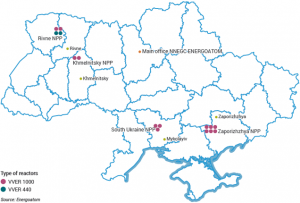Russia’s Radioactive Gamble in Ukraine
Elif Karaalioğlu
Analyst, EDAM Defense Program
Key Takeaway
- Attacks in Chernobyl and Zaporizhzhia Nuclear Power Plants (NPP), so far, have not led to a regional nuclear disaster. Nevertheless, the Russian military’s reckless strikes on critical facilities have opened a dangerous chapter, resembling the Cold War catastrophes.
- As missile strikes pound Ukraine and Russian Ground Forces gear-up for a more heavy-handed offensive, safety of South Ukraine, Khmelnitski, and Rivne NPPs must be maintained at all costs, in addition to already troubled Chernobyl and Zaporizhzhia. Especially, South Ukraine NPP remains at the highest risk due to its geo-location.
Bells Tolling for a Radiological Disaster
The Russian Federation’s large-scale military invasion in Ukraine certainly brought back the old fear of ‘radiological fallout’ to minds. President Putin dropped the bombshell as the fire broke out in the Zaporizhzhia NPP after being attacked by the Russian military on March 4, 2022. The State Nuclear Regulatory Inspectorate of Ukraine officially announced that the site was occupied by the Armed Forces of the Russian Federation. According to the statement, power units remained intact and no changes in the radiation situation have been registered, as yet. However, open-source intelligence showcased the damage made by Russian shelling in the facility’s administrative building. Had the fire at the NPP wasn’t stopped, its consequences would have been grave, plaguing the lives of next generations. Ukrainian President Volodymyr Zelensky clearly stated that an explosion there would be “the end of Europe”.

Fire fight at the Zaporizhzhia Nuclear Power Plant. Source: The New York Times
In fact, before Zaporizhzhia in the southern sector, the Russian forces have already taken control of the Chernobyl NPP in the northern front, which should have been alarming enough concerning the fate of nuclear energy facilities across Ukraine. Recently, the Ukrainian administration has informed the International Atomic Energy Agency that the Chernobyl NPP was “disconnected from the electricity grid and lost its external power supply”. Director General of IAEA Rafael Mariano Grossi expressed that the NPP’s lack of power was likely to lead to a further deterioration of operational radiation safety at the site. On March 15, Ukraine told the IAEA that the Chernobyl NPP was “re-connected to the national electricity grid, and no longer relied on emergency diesel generators for power”.
Mapping the Nuclear Catastrophe in the Making
Ukraine is dependent on nuclear energy. Apart from Chernobyl, which is permanently closed, there are four other NPPs in Ukraine with 15 reactors overall. Khmelnitski is near Netishyn and located in the western part of Ukraine. This NPP has two operational and two non-operational reactors, which are currently under construction. The second NPP is Rivne of Varash, situated close to the border with Belarus. Rivne NPP has four reactors in total.
As the largest NPP, Zaporizhzhia is in the southern part of Ukraine located in Energodar with six operational reactors. At present, Russian Rosgvardia personnel are guarding the captured NPP. These internal security units are trained for critical facility protection, but they cannot be reliable in detecting, let alone managing, a potential radioactive leak.
Lastly, the South Ukraine NPP in Mykolaiv is a flashpoint that needs to be monitored closely. The facility has three reactors. This particular facility is close to Odessa and Kherson. Due to its proximity to the areas where fierce clashes take place, the South Ukraine faces a serious challenge.

Nuclear Power Plants and reactors in Ukraine. Source: World Nuclear Association
What Next?
Recent assaults targeting the NPPs indicate that Putin’s strategic intention is reminding the Cold War traumas to Europe, and signalling a ‘stay away’ warning. However, the Russians are doing a very clumsy job in high-risk facilities. Technically, Chernobyl’s disconnection from the electricity grid was a truly bad sign. Engaging a firefight in such facilities is unacceptable. The war in Ukraine, therefore, has already become something way bigger than an inter-state armed conflict.
The protection of the above-mentioned nuclear power plants and setting-up a security shield around them must be a primary safety concern. With the recent attacks, the diplomacy becomes essential. It is highly important for international bodies and the West to raise the issue before it turns into a true disaster.




